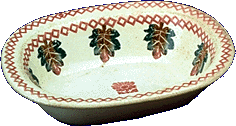SPONGED WARES
Wares more suited for the country than the urban market formed an important part of the Canadian ceramic trade. Into this category fell a class of white or cream-coloured earthenware known as sponged ware, which was given a category of its own in the china merchants' advertising.
Its "bright and fancy" decoration was effected by means of sponging or dabbing. Although Staffordshire supplied some of it, it came in great part from Scottish potters and was described by a Scottish writer in the 1920s as effected by means of "designs cut from the roots of sponges" and used "in conjunction with underglaze colours."
 |
 |
Vegetable Dish, circa 1895
Maker: Unmarked
Scotland
Canadian Museum of Civilization
Cat. no. 978.28.2
Photo S97-17880, CD2004-876 |
|
 |
 |
Jug, circa 1880
Maker: Unmarked
Scotland
Canadian Museum of Civilization
Cat. no. A-3484
Slide no. 17880 |
|
Sometimes there was no formal design, the decoration being simply dabbed on. At other times sponging was used along with freehand painting executed in a broad, quick style.
 |
 |
Pitcher, circa 1895
Maker: Unmarked
Scotland
Canadian Museum of Civilization
Cat. no. 978.28.1
Photo S97-17879, CD2004-876 |
|
Inexpensive and colourful, sponged wares were available in Canada in tablewares, toilet wares, kitchen bowls and even toywares. Sponged wares first became a significant part of the nineteenth-century Canadian trade around the 1850s; their popularity lasted well into the twentieth century. Ireland's Belleek factory, better known for its eggshell-thin porcelain, also supplied some of these wares to Canada.
|

